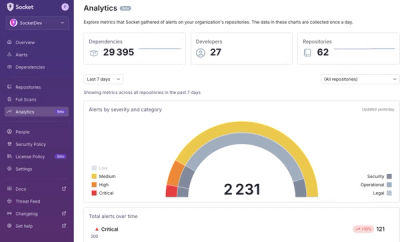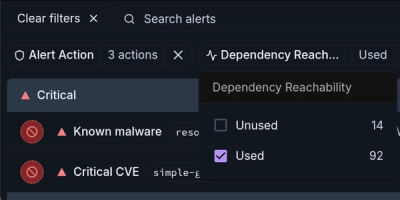
Security News
CISA Rebuffs Funding Concerns as CVE Foundation Draws Criticism
CISA denies CVE funding issues amid backlash over a new CVE foundation formed by board members, raising concerns about transparency and program governance.
ngx-translatekit
Advanced tools
“NgxTranslatekit is an essential library for Angular applications, designed to streamline the integration of internationalization, enabling seamless support for multiple languages and regional settings.”


npm install ngx-translatekit --save
Integrate NgxTranslatekitService into your Angular application:
import { Injectable, inject } from '@angular/core';
import { HttpClient, HttpParams } from "@angular/common/http";
import { Observable, takeUntilDestroyed } from "rxjs";
import { Languages } from "./languages";
@Injectable({
providedIn: 'root'
})
export class NgxTranslatekitService {
private libreTranslateUrl = 'https://translate.fedilab.app/';
constructor(private http: HttpClient) {}
detectLocale(): string {
return navigator.language;
}
getAvailableLanguages(): Observable<Languages[]> {
return this.http.get<Languages[]>(this.libreTranslateUrl + 'languages');
}
translateText(text: string, targetLanguage: string): Observable<string> {
const params = new HttpParams()
.set('q', text)
.set('source', 'auto')
.set('target', targetLanguage);
return this.http.post<{ translatedText: string }>(
this.libreTranslateUrl + 'translate',
null,
{ params }
).pipe(
map(response => response.translatedText)
);
}
}
import {
Component,
DestroyRef,
inject,
OnInit,
} from '@angular/core';
import {RouterOutlet} from '@angular/router';
import {NgxTranslatekitService, RtlSupportDirectiveDirective} from 'ngx-translatekit';
import {Languages} from "./languages";
import {takeUntilDestroyed} from "@angular/core/rxjs-interop";
import {FormsModule} from '@angular/forms';
import {HttpClient} from "@angular/common/http";
import {NgForOf} from "@angular/common";
@Component({
selector: 'app-root',
standalone: true,
imports: [RouterOutlet, FormsModule, NgForOf, RtlSupportDirectiveDirective],
providers: [NgxTranslatekitService],
templateUrl: './app.component.html',
styleUrl: './app.component.scss'
})
export class AppComponent implements OnInit {
title = 'test-ngx-translatekit';
languages: Languages[] = [];
translatedJson: any = {};
selectedLanguage = 'en';
currentDate: any;
private readonly destroyRef = inject(DestroyRef);
private readonly translationService = inject(NgxTranslatekitService);
private readonly http = inject(HttpClient);
ngOnInit(): void {
this.getLanguages();
this.loadJsonFile();
if (this.translationService.detectLocale() !== undefined) {
this.selectedLanguage = this.translationService.detectLocale().split('-')[0];
this.currentDate = new Date().toLocaleDateString();
console.log(this.currentDate);
}
}
onLanguageChange(selectedLang: string): void {
this.selectedLanguage = selectedLang; // Set the current language
this.loadJsonFile();
}
getLanguages(): void {
this.translationService.languages()
.pipe(takeUntilDestroyed(this.destroyRef))
.subscribe((languages: any) => {
this.languages = languages;
});
}
loadJsonFile() {
this.http.get('assets/content.json', {responseType: 'json'})
.pipe(takeUntilDestroyed(this.destroyRef))
.subscribe(data => {
this.translateJson(data);
}, error => {
console.error('There was an error!', error);
});
}
translateJson(data: any): void {
Object.keys(data).forEach(key => {
this.translationService.translate(data[key], this.selectedLanguage)
.pipe(takeUntilDestroyed(this.destroyRef))
.subscribe(translation => {
this.translatedJson[key] = translation;
});
});
}
}
<div libRtlSupportDirective [currentLang]="selectedLanguage" class="container-fluid">
<header class="row bg-dark">
<div class="col-md-12 bg-primary text-light py-2">
<h1 #main_header>{{ translatedJson.header }}</h1>
</div>
</header>
<main class="row">
<nav class="navbar navbar-expand-lg navbar-light bg-light">
<a class="navbar-brand" href="#">Navbar</a>
<button class="navbar-toggler" type="button" data-toggle="collapse" data-target="#navbarTogglerDemo02"
aria-controls="navbarTogglerDemo02" aria-expanded="false" aria-label="Toggle navigation">
<span class="navbar-toggler-icon"></span>
</button>
<div class="collapse navbar-collapse" id="navbarTogglerDemo02">
<ul class="navbar-nav mr-auto mt-2 mt-lg-0">
<li class="nav-item active">
<a class="nav-link" href="#">Home <span class="sr-only">(current)</span></a>
</li>
<li class="nav-item">
<a class="nav-link" href="#">Link</a>
</li>
</ul>
<select [(ngModel)]="selectedLanguage" (ngModelChange)="onLanguageChange(selectedLanguage)">
<option *ngFor="let language of languages" [value]="language.code">{{ language.name }}</option>
</select>
</div>
</nav>
<div class="col-md-12 col-lg-12 py-3">
<div class="main-content">
<div class="card border-primary mb-3">
<div class="card-header">{{ currentDate +' ' + translatedJson.header }}</div>
<div class="card-body text-primary">
<h5 class="card-title" #title>{{ translatedJson.title }}</h5>
<p class="card-text">{{ translatedJson.paragraph }}</p>
</div>
</div>
</div>
</div>
</main>
</div>
You can use this css to support on right-to-left and vice versa
.rtl {
direction: rtl;
text-align: start; /* 'start' will align text to the right in RTL mode */
}
/* Other styles to adjust padding, margins, etc., for RTL layout */
.rtl .some-class {
padding-right: 15px;
padding-left: 0;
}
This is how to use the directive
<div libRtlSupportDirective [currentLang]="selectedLanguage"></div>
import {Directive, ElementRef, Input, OnChanges, OnInit, Renderer2} from '@angular/core';
@Directive({
selector: '[libRtlSupportDirective]',
standalone: true
})
export class RtlSupportDirectiveDirective implements OnInit, OnChanges {
@Input() currentLang = 'en';
constructor(private el: ElementRef, private renderer: Renderer2) {
this.adjustLayoutForRtl();
}
ngOnInit(): void {
console.log('currentLang: ',this.currentLang);
this.adjustLayoutForRtl()
}
ngOnChanges() {
this.adjustLayoutForRtl(); // React to changes in currentLang
}
adjustLayoutForRtl() {
if (this.isRtlLanguage(this.currentLang)) {
this.renderer.addClass(this.el.nativeElement, 'rtl');
} else {
this.renderer.removeClass(this.el.nativeElement, 'rtl');
}
}
isRtlLanguage(lang: string): boolean {
// Add all RTL languages you want to support
const rtlLanguages = ['ar', 'he', 'fa', 'ur']; // arabic | hebrew | persian | urdu
return rtlLanguages.includes(lang);
}
}
The RtlSupportDirectiveDirective is a pivotal feature of the NgxTranslatekit library, designed to enhance the user experience for languages that are read from right to left. This directive dynamically adjusts the layout of an Angular application based on the current language selection, ensuring that text and other elements are correctly aligned for languages such as Arabic, Hebrew, Persian, and Urdu.
Here’s a brief overview of its functionality:
It listens for changes in the language and automatically applies the ‘rtl’ class to elements, flipping the layout to match the reading direction of RTL languages.
By default, it supports a set of RTL languages but can be easily extended to include more languages as needed.
With simple input binding, the directive can be applied to any element that requires RTL support, making it a versatile tool for developers.
As a standalone directive, it can be imported and used independently, allowing for modular and clean code architecture.
This is the JSON file to translate
{
"header": "Ngx-TranslateKit Library",
"title": "Ngx-TranslateKit Library for developers",
"paragraph": "Ngx-TranslateKit is a comprehensive library for Angular applications that facilitates internationalization by allowing developers to easily translate their apps into multiple languages. It provides a powerful translation service, along with a pipe and directive, to manage translations and dynamically load language files from the server. The library supports Angular’s modular architecture, enabling developers to import it in the root module with TranslateModule.forRoot() for application-wide usage or in feature modules using TranslateModule.forChild(). With ngx-translatekit, developers can enhance their applications’ global reach by providing a localized user experience"
}
This is how the translated page will look like:
Microservice architecture is a very popular approach in designing and implementing highly scalable web applications. Communication within a monolithic application between components is usually based on method or function calls within the same process. A microservices‑based application, on the other hand, is a distributed system running on multiple machines.
Ngx-Translate کتابخانه کیت برای توسعه دهندگان
Ngx-Translate کیت یک کتابخانه جامع برای برنامه های Angular است که تسهیل بین المللی سازی با اجازه دادن به توسعه دهندگان به راحتی ترجمه برنامه های خود را به چندین زبان است. این یک سرویس ترجمه قدرتمند، همراه با یک لوله و دستورالعمل، برای مدیریت ترجمه ها و فایل های زبان به طور پویا بارگذاری از سرور فراهم می کند. کتابخانه از معماری مدولار Angular پشتیبانی می کند، توسعه دهندگان را قادر می سازد تا آن را در ماژول ریشه با TranslateModule.ForRoot() برای استفاده در سراسر برنامه یا ماژول های ویژگی با استفاده از TranslateModule.forChild وارد کنند. با ngx-Translatekit، توسعه دهندگان می توانند دسترسی جهانی برنامه های خود را با ارائه یک تجربه کاربری محلی افزایش دهند
Supported Languages English [ en ]
Arabic [ ar ]
Azerbaijani [ az ]
Catalan [ ca ]
Chinese [ zh ]
Czech [ cs ]
Danish [ da ]
Dutch [ nl ]
Esperanto [ eo ]
Finnish [ fi ]
French [ fr ]
German [ de ]
Greek [ el ]
Hebrew [ he ]
Hindi [ hi ]
Hungarian [ hu ]
Indonesian [ id ]
Irish [ ga ]
Italian [ it ]
Japanese [ ja ]
Korean [ ko ]
Persian [ fa ]
Polish [ pl ]
Portuguese [ pt ]
Russian [ ru ]
Slovak [ sk ]
Spanish [ es ]
Swedish [ sv ]
Thai [ th ]
Turkish [ tr ]
Ukranian [ uk ]
Vietnamese [ vi ]
Please follow this guidelines when reporting bugs and feature requests:
Thanks for understanding!
The MIT License (see the LICENSE file for the full text)
FAQs
This is a translator that does translation.
The npm package ngx-translatekit receives a total of 2 weekly downloads. As such, ngx-translatekit popularity was classified as not popular.
We found that ngx-translatekit demonstrated a not healthy version release cadence and project activity because the last version was released a year ago. It has 1 open source maintainer collaborating on the project.
Did you know?

Socket for GitHub automatically highlights issues in each pull request and monitors the health of all your open source dependencies. Discover the contents of your packages and block harmful activity before you install or update your dependencies.

Security News
CISA denies CVE funding issues amid backlash over a new CVE foundation formed by board members, raising concerns about transparency and program governance.

Product
We’re excited to announce a powerful new capability in Socket: historical data and enhanced analytics.

Product
Module Reachability filters out unreachable CVEs so you can focus on vulnerabilities that actually matter to your application.